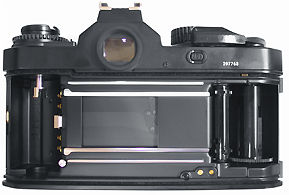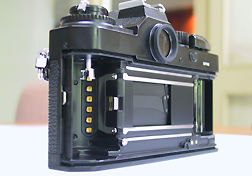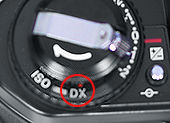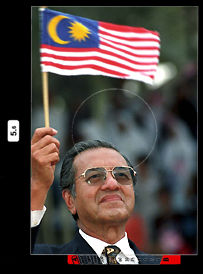 |
Next, let me go through the internal section of the camera. To open the film back, just pull the film rewind knob upward. Once the film back is open the original purchaser of a Nikon FM3a, will find a plastic placard that serves as a reminder not to touch the delicate shutter curtain. You have to remove this piece of plastic prior attempting to use the camera. |
 |
This is what the FM3a looks like with the film back removed. Seemingly identical to previous FM2n/FE2 model(s) in design, except at film chamber section, there is an array of six inline gold plated contacts used for automatic DX-film speed coding. There is also a spring-loaded, cartridge-positioning metal tab to ensure the film cartridge is held firmly in place. |
* Together with the film confirmation window FM3a is the first* Manual focus Nikon SLRs within the FM/FE/FA series to have this useful feature incorporated for the first time in these bodies. Nikon F301 (N2000) of 1985 was the first Nikon SLR camera that provides DX-coding feature. It was also the first to incorporate a built-in winder to handle automation film advance and film rewinding.
 |
The FM3a DX coding system will minimize chances of disappointing photographic experience caused by human errors during setup. It automatically detects the film's ISO film speed from the bar-code (silver and black lining imprinted on the film canister). So users doesn't have to worry of setting wrong film speed during setup or even changing film roll of different nature in film speed halfway through shooting session. The film sensitivity range for automatic film speed recognition DX system is from a low ISO 25 to 5000. However, should you decide to change to manual and override the auto film speed setting, the film speed range is extended form a even lower ISO 12 to a high 6400 on both end of the scales. |
The film speed settings are located at the camera's top panel just underneath film rewind knob. To learn how to make good use of it, please refer to the Owner's Manual section. My personal advice is, don't be a hero - unless you are aware what you are doing, always set the camera's film speed to default DX position to minimize possible mistakes - some oversight might ruin your entire effort (or may even caused embarrassment if being engaged in important assignment(s)). I have made some mistakes over the years for not paying attention to this too and I have been longing for such a feature in my FM2/T and my F3/T bodies. And it is only been realized in the FM3a. Good effort, Nikon !
 |
Note : The film speed index is marked in red for easy visual identification. If you load a non-DX-coded film with the film-speed index set at marking or if no film is loaded, the exposure-compensation indicator and the flash ready light alternately blinks to remind you to adjust the correct film speed according to the film speed used OR in the case if there is no film inside the film compartment, both the exposure compensation and flash icon inside the viewfinder will blink continuously. |
Overall, I enjoy the convenience the auto DX film speed recognition feature provides. Along with the simple film confirmation window, both have greatly enhanced the camera's functionality and practicality. Although none of them are considered great innovations as both have been a standard feature found on even many entry level automatic AF SLR cameras. But they have been cleverly adopted and incorporated this in the FM3a to aid careless SLR users like me. Personally, these two features are one of the three main attractions presented in the Nikon FM3a.
 |
The manual film transport system employed in the FM3a deserves some mention as it is the result of well tested and proven knowledge acquired from other FM class models. As good film transport system will not only take on the demands of manual film advance and also ensuring intentional, accurate-registration double or multiple exposure operation. Reliable and smooth film transport is also essential to withstand the punishment of continuous motorized shooting. Precise focusing, absolute film flatness and positive film travel are three essential elements to picture sharpness. |
The metal tab and spring guide in the film chamber (next to the gold plated DX contacts) actually act as a film cassette stabilizer that prevents the cassette from wobbling, ensuring correct film positioning and positive communication with the Barcode on the film canister. In actual operation of film installing, the film leader can then be pulled out and fed into the film take-up spool on the other end of the camera, while two sets of sprocket gears which are made of durable material engage the sprocket holes, or perforations, on either side of the film. The take-up spool itself has three slots, any of which can be used for easy film leader insertion; it winds the film emulsion-side-out to effectively negate its natural tendency to curl in on the emulsion side. Lastly, the large film pressure plate, on the reverse side of the camera back, keeps the film perfectly flat in the crucial area across the film gate.
Nikon cameras have always been famed for their high efficient, low torque film travel with good use of choice materials to meet individual expectation for long lasting, trouble-free operation. In fact. the quality feel is all over in the FM3a once you have opened the film back. The corrosive resistant stainless steel film rail guide and two film rails running across just above the shutter curtain in FM class bodies are very durable and seldom do you see them get rusty over years (But the FE2 was suspiciously using aluminum alloy because I have seen many of them get corroded). The film rails keep the film perfectly straight; smooth running is assisted by the roller-type film guide pin which rotates to eliminate any damage to the film that may be caused by friction as it travels, Unlike many other rivaling brands which choose alternative materials, I think Nikon has paid good attention in these areas to ensure positive and reliable film transport system. Just at the bottom right hand corner, under the film take up wheel, you will find two gold plated electrical contacts. These are for synchronizing with a Databack for imprinting of data onto the film.
 |
 |
Lastly, just a little general knowledege on the hardware - below the serial number, there is a hidden pin inside the film back railing. This is the frame counter reset pin. There is another protruding edge at the film back that will automatically snap-in the pin once the back is close. Spring open the back will automatically reset the frame counter to zero. |
In time to come, when your camera is aged and if the counter gives some problem, try checking this section of the body to see if it is the cause.
| Previous | NEXT | The top panel, the command center section of the FM3a.
Page 1 | 2 | 3 | 4 | 5 | 6 | 7 | 8 | 9 | 10 | 11 | 12 |
| BACK | to Main Index Page
of Nikon FM3A
|
Other
Issues
relate to Nikon FM3A - Index
Page
|
| Instruction Manual for Nikon FM3A
|
| Technical Specification |
Main
Reference Map
|
Standard
production Nikon FM Series models:-
Nikon FM | Nikon FM2 | Nikon FM2n | Nikon FM10 | Nikon FM3a |
Known
variants:-
Nikon
FM Gold
| Nikon
FM2/T
| Nikon
FM2N Tropical Set
| Nikon
FM2/T Limited Edition
| Nikon
FM2N LAPITA
|
Nion
FM2n Millennium 2000
| Message Board | for
your favourite Nikon
FM Series SLR models
| Message
Board | for your Nikon
Optics in a shared environment
| Message Board | Specifically for Dispose or Looking for Nikon/Nikkor
Photographic Equipment
| Back | Main Index
Page of Nikon FM series Bodies
Shared Resources: MD-11 | MD-12 | Focusing Screens | Titanium Shutter | older dedicated Flash Units for FM series -SB-16 | SB-15 | SB-10 or other Options | Databack | Nikkor lens mount (related info)
Others:- Nikon AF-TTL Speedlights | SB-20 (1986) | SB-22 (1987) | SB-23 | SB-24 (1988) | SB-25 (1991/2) | SB-26 (1994) | SB-27(1997) | SB-28 (1997) | Nikon SB-29(s) (2000) | Nikon SB-30 (2003) | Nikon SB-600 (2004) | Nikon SB-800 (2003) Nikon AF-TTL Speedlight DX-Series: Nikon SB-28DX (1999) | SB-50DX (2001) | SB-80DX (2002) (updated)
Nikon
BC-flash Series |
Original
Nikon Speedlight
SB-2
| SB-3
| SB-4
| SB-5
| SB-6
| SB-7E
| SB-8E
| SB-9
| SB-E
| SB-10
SB-11
| SB-12 | SB-14 | SB-140 UV-IR| SB-15 | SB16A | SB-17 | SB-18, SB-19 | SB-21A (SB-29) Macro flash | Flash Accesories | SF-1
Pilot Lamp
Instruction
Manual: Nikon FM (HTML | PDF) | Nikon FM-10 (HTML) | Nikon FM2n's
User's Manual
available only in HTML format (6
parts) | Nikon FM3A (HTML)
Specifications: Nikon FM, FM-10, FM2, FM2n and FM3A
Main Reference Map: (HTML) Nikon FM, FM2, FM-10, FM2n (Applicable
to FM2T, FM2 "Year of the Dog"; Millennium 2000") and FM3A
| Nikon F | Nikon F2 | Nikon F3 | Nikon F4 | Nikon F5 | Nikon F6 | Nikkormat / Nikomat | Nikon FM | Nikon FE/ FA | Nikon EM/FG/FG20 | Nikon Digital SLRs | Nikon - Other models |
Nikon Auto Focus Nikkor lenses:- Main
Index Page
Nikon Manual Focus Nikkor lenses:- Fisheye-Nikkor Lenses - Circular | Full Frame |
Ultrawides Lenses - 13mm15mm18mm20mm | Wideangle Lenses - 24mm28mm35mm | Standard Lenses - 45mm 50mm 58mm | Telephoto
Lenses - 85mm105mm135mm180mm & 200mm | Super-Telephoto Lenses - 300mm 400mm 500mm 600mm 800mm 1200mm |
 Index Page |
Special
Application lenses: Micro-Nikkor Lenses - 50mm~55mm -60mm 85mm -105mm 200mm Micro-Zoom 70-180mm Perspective Control (PC) - 28mm 35mm PC-Micro 85mm Dedicated Lenses for Nikon F3AF: AF 80mm f/2.8 | AF 200mm f/3.5 EDIF Depth of Field Control (DC): 105mm 135mm Medical Nikkor: 120mm 200mm Reflex-Nikkor Lenses - 500mm 1000mm 2000mm Others: Noct Nikkor | OP-Nikkor | UV Nikkor 55mm 105mm | Focusing Units | Bellows-Nikkor 105mm 135mm Nikon Series E Lenses: 28mm35mm50mm100mm135mm | E-Series Zoom lenses: 36~72mm75~150mm70~210mm |
MF Zoom-Nikkor Lenses: 25~50mm | 28~45mm | 28~50mm | 28~85mm | 35~70mm | 36~72mm E | 35~85mm | 35~105mm | 35~135mm | 35~200mm | 43~86mm | 50~135mm | 50~300mm | 70~210mm E | 75~150mm E | 80~200mm | 85~250mm | 100~300mm | 180~600mm | 200~400mm | 200~600mm | 360~1200mm | 1200~1700mm
Tele-Converters: TC-1 | TC-2 | TC-200 | TC-201 | TC-300 | TC-301 | TC-14 | TC-14A | TC-14B | TC-14C | TC-14E | TC-16 | TC-16A | TC-20E
Recommended links to understand more technical details
related to the Nikkor F-mount and production Serial Number:
http://rick_oleson.tripod.com/index-153.html by: my
friend, Rick Oleson
http://www.zi.ku.dk/personal/lhhansen/photo/fmount.htm by: Hansen,
Lars Holst
http://www.mir.com.my/rb/photography/hardwares/nikonfmount/lens2.htm
http://www.photosynthesis.co.nz/nikon/serialno.html
W A R N I N G: The New G-SERIES Nikkor lenses have no aperture ring on the lens, they CANNOT ADJUST APERTURES with any of these manual focus Nikon FE series SLR camera models; please ignore some portion of the content contained herein this site where it relates.
|
Back | Main Index Page of Nikkor Resources
|
Back | Main Index Page of Pictorial
History of Nikon SLRs
| Message Board | for your Nikkor optics ("shared" because I do wish some of you to expose to other's perspective as well. Isn't it a sad sate to see photography has to be segmented into different camps from the use of various labels)
about this photographic web site
Home - Photography in Malaysia |
Credit: To all the good people who has contributed their own experience, resources or those who are kind enough granting us permission to use their images appeared in this site. Mr. MCLau®, who has helped to rewrite some of the content appeared this site. Chuck Hester® who has been helping me all along with the development of all these Nikon websites;LarsHolst Hansen, 'Hawkeye' who shares the same passion I have; Ms Rissa, Sales manager from Nikon Corporation Malaysia for granting permission to use some of the official content; TedWengelaar,Holland who has helped to provide many useful input relating to older Nikkor lenses; Some of the references on production serial numbers used in this site were extracted from Roland Vink's website; HiuraShinsaku from Nikomat Club Japan. t is also a site to remember a long lost friend on the Net. Note:certain content and images appeared in this site were either scanned from official marketing leaflets, brochures, sales manuals or publications published by Nikon over the years and/or contribution from surfers who claimed originality of their work for educational purposes. The creator of the site will not be responsible for may discrepancies arise from such dispute except rectifying them after verification."Nikon", "Nikkormat", "Nippon Kokagu KK" & "Nikkor" are registered tradename of Nikon Corporation Inc., Japan. Site made with an Apple IMac.